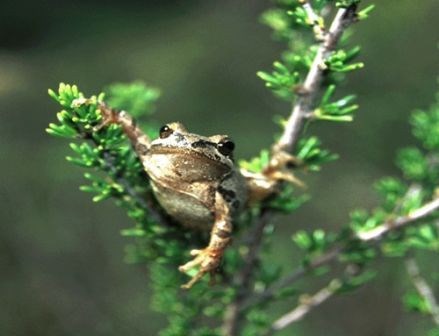Feeding
Baja California Treefrogs eat a wide variety of invertebrates, including a high percentage of flying insects. Tadpoles are suspension feeders, eating a variety of prey including algaes, bacteria, protozoa and organic and inorganic debris.
Reproduction
In the Santa Monica Mountains and Simi Hills, mating and egg-laying generally occur from November until July. Males first migrate from their moist terrestrial habitats to wetland breeding areas. There they make their advertisement calls which, in turn, attract more males, then eventually females. Egg-laying takes place in slow streams, permanent, seasonal and artificial ponds, reservoirs, natural and roadside ditches, marshes, shallow vegetated wetlands, and wet meadows. Females lay on average between 400-750 eggs in small, loose, irregular clusters of 10-80 eggs each. Egg clusters are attached to sticks, stems, or grass in quiet shallow water. The eggs hatch in two to three weeks. Eggs appear to be resistant to the negative effects of solar UV-B radiation and even to increased water acidification.
Large schools of tadpoles often feed in shallow water, aggregating for thermoregulation and to avoid predation. Tadpoles are blackish to dark brown, and grow to less than 2 inches in length before metamorphosis. Tadpoles enter metamorphosis in about 2 months, around June to late August. When in the process of metamorphosis, many tadpoles are often seen in aggregations at the edge of a pond. Juvenile treefrogs may either stay and spend the winter, or disperse to nearby sites.
Conservation Status
Though there are no significant conservation concerns for this species in California, tadpoles are sensitive to nitrites and excess nitrite concentrations from agricultural and urban runoff. The park's aquatic amphibian monitoring program has also shown a decrease in Baja California Treefrog abundance in streams that are also occupied by non-native crayfish.

